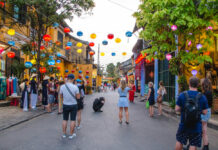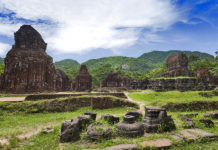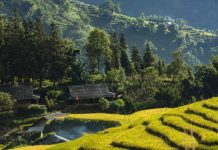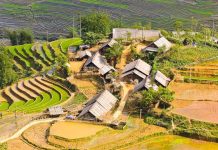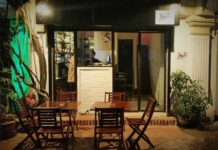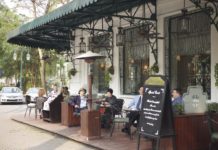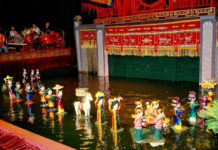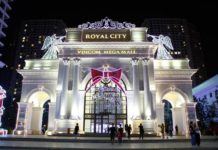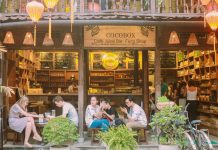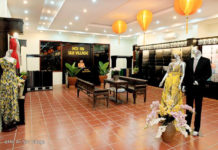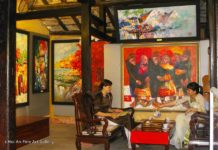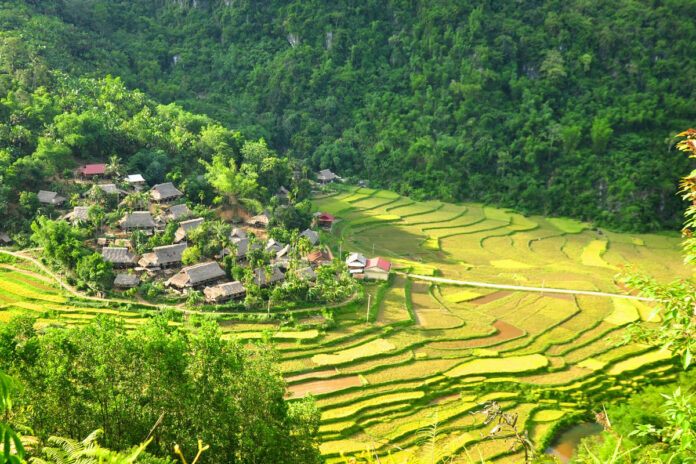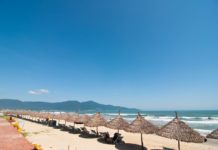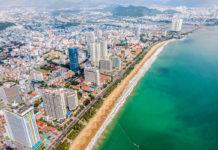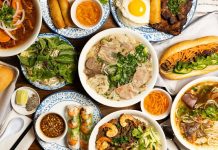Nestled in the mountains of Northern Vietnam, Pù Luông Nature Reserve offers some of the most spectacular trekking opportunities in the country. Known for its breathtaking limestone peaks, dense tropical forests, and cascading rice terraces, Pù Luông is quickly becoming a favourite destination for hikers seeking to explore Vietnam’s great outdoors.
How to get to Pu Luong – bus or private car
By public bus
To reach Pù Luông by public bus, you’ll need to catch a bus from either Hanoi or Thanh Hoa to the small town of Cuc Phuong. Buses depart regularly throughout the day. From Cuc Phuong, you can hire a local motorbike to take you the remaining 30km into Pù Luông Reserve. The entire bus and motorbike journey takes around 5 hours.
Pros:
- Very affordable way to reach the reserve
- Allows you to mingle with locals
Cons:
- Inconvenient and time-consuming with bus changes
- You’ll need to negotiate rates with motorbike drivers
By private car
Another option is hiring a private car and driver for the journey from Hanoi or Thanh Hoa. The drive takes around 3.5-4 hours. Most hotels and tour agencies in Hanoi offer car transfers.
Pros:
- Fastest and most convenient way to reach Pu Luong
- No need to worry about directions or getting ripped off
Cons:
- More expensive than public bus
The Best time for trekking in Pu Luong Nature Reserve
Dry season (October to April)
The dry months between October and April are considered the ideal time to trek in Pù Luông. During this season, trails are dry, skies are clear, and temperatures are moderately cool. Rice paddies shimmer bright green around January-February.
Wet season (May to September)
While the reserve remains open year-round, the wet summer months can see heavy rain, flooded fields, and slippery trails. However, the lush greens and fewer tourists can appeal to some.
Peak season (October to December)
Autumn draws peak crowds with cool weather and ripe rice paddies. Book accommodation well in advance during this timeframe.
Low season (January to April)
The reserve quietens down after the holiday period. January through April still offers fine weather with fewer tourists. A great time for a more private, peaceful experience.
Where to stay in Pu Luong Nature Reserve?
Homestays
For full cultural immersion, overnight in one of the small Thai villages within the reserve. Rustic homestays provide the chance to bond with ethnic minority communities and learn about local lifestyles. Most homestays include all meals.
Pros: Authentic experience, cultural insight, local food, supports villagers
Cons: Very basic amenities, language barriers, early nights
Eco-lodges
Several eco-lodges are now operating around Pu Luong, catering to travellers with more comfort. While not luxurious, these lodges offer private rooms with en-suites, decent food, and professional service.
Pros: More amenities than homestays, beautiful natural locations, exposure to village life
Cons: Less cultural immersion than homestays, can feel touristy
Hotels
A small selection of hotels with pool facilities can be found down in the valleys around Pu Luong town and Cuc Phuong. These provide upscale accommodation options after your trek.
Pros: Familiar amenities like pools/room service, scenic locations, chance to relax post-trek
Cons: Isolated from village life, less cultural experience, added expense
Eating in Pu Luong
Pu Luong offers a delightful mix of Vietnamese cuisine and Thai specialties thanks to its ethnic minority communities. Here’s what to try:
Local specialties
Sample unique dishes like mọc (pork salad with local herbs), Thai-style sour soup (canh chua), grilled river fish, stir-fries with wild vegetables, and lots of rice varieties. Don’t miss the chance to enjoy a traditional cơm lá feast – this is an elaborate meal involving food cooked inside bamboo sticks placed directly in the fire.
Homestay meals
For the true local experience, enjoy home-cooked meals with an ethnic minority family in their wooden stilt home. Typical dishes feature ingredients harvested from nearby rice paddies and kitchen gardens along with foraged mushrooms and bamboo shoots from the jungle. Expect simple but flavoursome food.
Trekking snacks
While trekking, keep energy levels high with bananas, nuts, boiled sweet potatoes and other handy snacks purchased in local villages. Stop somewhere picturesque to enjoy your portable picnic with sensational valley views!
Trekking routes in Pu Luong Nature Reserve
Pu Luong Nature Reserve boasts an excellent network of trekking trails catering to all levels. Routes wind through rice terraces, tropical jungle, over hanging suspension bridges, and up to panoramic peak viewpoints. Here are some favourite treks to consider:
Trekking to Pu Luong Peak
The hike to the reserve’s highest mountain, Pu Luong Peak, makes for a challenging one day trek but rewards the effort with astounding 360° views across the entire valley from the 1,700 metre summit. Popular with more seasoned hikers.
Key details:
- 16 km circuit
- 6-8 hours duration
- Strenuous difficulty level
- 1,700 m elevation gain
Trekking through Son Ba Muoi
This picturesque valley surrounded by limestone cliffs oozes tropical charm and cultural insights. Explore Son Ba Muoi village, walk bamboo bridges, visit historic thatch roof houses, trek to watering holes and enjoy swimming beneath waterfalls. More relaxed pace over two days.
Key details:
- 12 km circuit spread over two days
- Moderate difficulty
- Waterfalls, minority villages and swimming
Trekking to Don Village
Ideal for those short on time – this easy half day trek provides gorgeous valley vistas with less elevation gain. Wind through endless rice terraces and water lily ponds to Don Village where you can interact with Thai people and enjoy tasty local dishes.
Key details:
- 8 km return route
- 3-4 hours duration
- Relatively flat and suitable for beginners
- Scenic valley views
Trekking from Uoi Village to Lan Village
Experience incredible bamboo rainforests and lush jungle on this demanding one day trek across the reserve. Pass through remote hill tribe villages and discover hidden waterfalls before finishing up for traditional food and homestay accommodation in Lan Village.
Key details:
- 15 km one way
- 7-8 hours duration
- Strenuous difficulty level
- Forest, village and waterfall attractions
Trekking to Hieu Village
Venture deep into lush jungle with this multi-day expedition to reach the remote Thai outpost of Hieu Village perched on a mountain ridge. Stay overnight in a traditional stilt house before ascending nearby Dragon Mountain for magical sunrises amid sea of clouds.
Key details:
- 22 km circuit over two days
- Challenging overnight trek through dense jungle
- Dragon Mountain summit sunrise
Packing tips for a Pu Luong trekking
When preparing your backpack for Pu Luong, focus on:
Essential gear
- Sturdy hiking boots/shoes – to cope with slippery terrain
- Daypack – for carrying water, snacks, rain jacket etc
- Walking sticks – helpful for steep ascents/descents
- Torch/headlamp – no lighting on remote trails
- Rain poncho – sudden showers are common
Clothing tips
Pack versatile layers you can add/remove:
- Breathable shirts – avoid cotton, which retains dampness
- Lightweight pants – zip-offs work well
- Warm layers – fleece jackets, down gilet
- Waterproof jacket – essential during wet season
- Comfortable socks – carry spares!
Other accessories
- Reusable water bottle – stay hydrated!
- Sunscreen – high UV here
- Camera – don’t forget to capture those views!
- Snacks – for energy boosts during longer treks
- Small first aid kit – carrying essentials like plasters
Notes when trekking in Pu Luong Nature Reserve
Permits: You must purchase an entry permit on arrival valid for the duration of your stay. Have small notes ready as park staff may not have change.
Guides: While none of the trails require guides, hiring a local English-speaking guide can provide helpful navigation and interesting cultural insights. Agree rates/inclusions upfront.
Cash: There are no ATMs in Pù Luong so carry sufficient cash for accommodation, food, entry fees and any guided treks or transport needs. Homestays may not accept cards.
Route planning: Discuss intended routes with your homestay or eco-lodge to match distances and difficulty levels to your fitness and experience. They can arrange any transfers required.
Responsible behaviour: As a national park, be sure to follow responsible visitor guidelines: stick to marked trails, don’t litter, refrain from feeding wildlife or removing plants. Ensure your guide follows park rules too.
FAQs
Do I need to book Pu Luong treks in advance?
While not essential, pre-booking treks is recommended during peak dry season to secure guides and preferred homestays, especially for larger groups. Travel in wet season is more flexible. Discuss options with your chosen accommodation upon booking.
Can children manage the treks?
Some short, easy routes around the reserve would be suitable for active teenagers but extended multi-day treks are not recommended for younger children due to terrain, distances and facilities. Assess individual routes based on your child’s previous hiking experience and fitness level.
Is it safe for solo female trekkers?
Absolutely! The trails around Pu Luong are not considered risky and locals are very welcoming of foreign visitors. As when hiking anywhere solo, be sensible: share your planned route with lodgings, don’t trek late afternoons, and consider hiring a guide for added reassurance if you have any concerns.
Conclusion
With towering limestone peaks, cascading rice paddies and charming hill tribe villages steeped in age-old traditions, Pù Luông Nature Reserve offers a spectacular location for an adventurous trekking escape. Whether you select easy valley trails through terraced farms or commit to tough multi-day jungle treks over mountain ridges, unforgettable scenery and cultural encounters await. Just be sure to travel with suitable footwear, pack for changing conditions, respect local communities and park rules – then prepare to fall in love with this lush Vietnamese wilderness.

